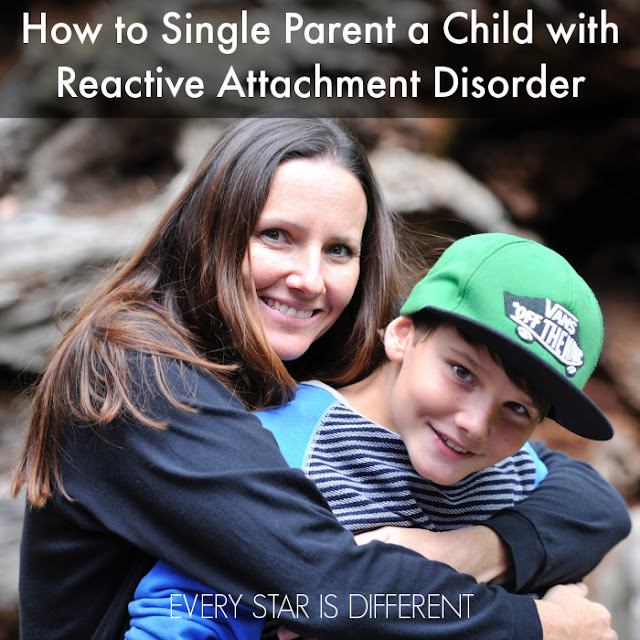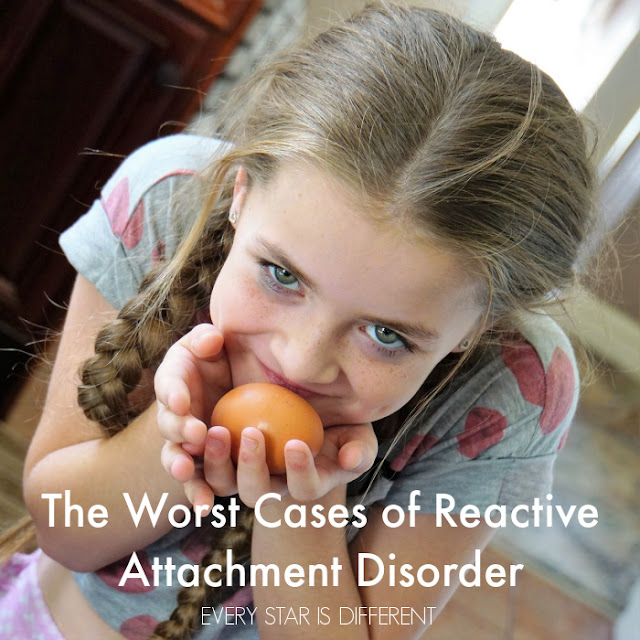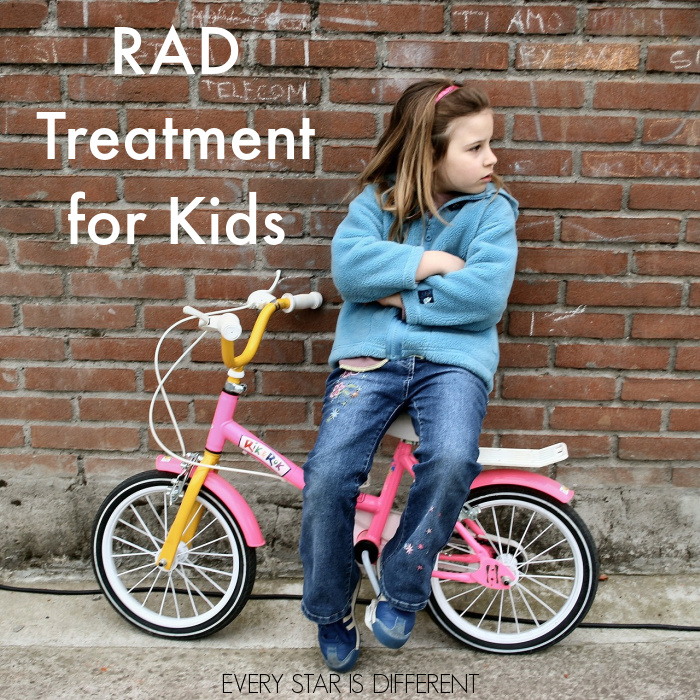On multiple occasions I've been asked for tips on how to care for a child with Reactive Attachment Disorder as a single parent.
Though I am not a single parent raising a child with RAD, I do have friends who are.
I have asked for their help with these tips.
In my marriage, there have been times when I have had to solo parent our four children due to certain circumstances for long periods of time.
This is NOT the same as being a single parent day in and day out with no end in sight.
Legally I was still married during these times. Though my husband was unable to parent at the time, I still had a partner.
I want to be very honest and upfront with you that the times I did solo parent children of RAD were the darkest days of my life.
Anxiety, depression, and trauma are all very real things and they can hit hard.
Had those time periods not ended, I can't say that I would be in the place I am today.
Unfortunately, there are many caregivers who are attempting to raise at least one child with Reactive Attachment Disorder on their own.
In many cases these caregivers have other younger and older children they are also caring for.
If you find yourself in this situation, here are my best tips, after receiving a lot of help from friends who single parent ALL THE TIME.
How to Single Parent a Child with Reactive Attachment Disorder
Warning: This
post contains content related to Reactive Attachment Disorder that may be
triggering to some.
Important: Children with RAD are
victims of abuse and/or neglect. Behaviors associated with Reactive Attachment
Disorder are due to how the brain forms while the innocent child is surviving
trauma. It is our goal to support healthy and loving families where children
with RAD can heal, if possible.
Prepare the Home Environment
Your home needs to be safe for everyone who lives there.
If you're looking for guidance in this area, be sure to check out the resource below.
Must Have Safety Resources When Parenting a Child with Reactive Attachment Disorder
The Worst Cases of Reactive Attachment Disorder
Create a Team for Emergencies
Children with Reactive Attachment Disorder have fits or explosions that can last hours.
During this time a caregiver is responsible for keeping the child and everyone else in the home safe.
This is extremely challenging when two parents are in the home, but when there is only one parent, there is no one to tag out and take turns with, until unsafe situations are over.
A caregiver of a child with Reactive Attachment Disorder is expected to remain calm, de-escalate the situation and co-regulate, just like any other caregiver would be.
When an unsafe behavior episode occurs and lasts hours, requiring mental, emotional, and sometimes physical exertion, remaining calm and doing everything right is HARD.
A child with Reactive Attachment Disorder may not respond well to de-escalation and co-regulating techniques.
8 Differences Between RAD Fits and Autism Meltdowns
In these situations it is crucial for a single parent to create a team for emergencies in order to stay safe and sane.
There are several options to consider.
When my husband was unavailable for long periods of time, and things were not okay at home, I reached out to my ecclesiastical leaders for help.
They were able to set up a rotation of people who were experienced in disabilities and aggression, who would come over to my home for a few hours a day, and help out.
When my youngest did have a fit or explosion, they would be there to care for my other kids and/or check in on me as I was handling unsafe behaviors.
At other times we had an at-home therapist that came to our home multiple times a week for a few hours at a time.
She would work with Sunshine and/or sit with me as I tended to unsafe situations, after ensuring that my other kids were safe, okay, and occupied.
A friend of mine, Sarah, a single parent of one child with Reactive Attachment Disorder, would handle fits and explosions on her own, but then once they were over, she would call someone on her emergency team to come watch her RAD child, while she took a break to cry, scream, and just let out her own emotions.
Find a solution that works best for you.
Create a Safety Plan for ALL Family Members when Unsafe Situations Arise
When Do I Consider Residential Placement for My Child?
Create a Financial Plan that Works and Be Okay with It
Job stability is hard in today's society.
When you're raising a child with Reactive Attachment Disorder, it becomes even harder.
You will miss work due to emergencies and unsafe behaviors.
Children with Reactive Attachment Disorder don't usually do well in group settings, which include extra-curricular activities and after school resources.
A caregiver cannot depend on these programs to handle RAD behaviors. This responsibility lies with the caregiver.
If possible, a single parent of a child child with Reactive Attachment Disorder, it's incredibly important to find a job that provides the flexibility you will need.
If you're unable to do this, and do not have financial reserves, as hard as it may sound, living in poverty in the United States opens doors for free medical insurance and resources including residential.
We are fortunate that our girls receive Medicaid until they become adults through their adoption, but in many situations children with RAD don't have free insurance, which limits resources and requires caregivers to pay significant out of pocket expenses for treatment.
Another aspect of raising a child with Reactive Attachment Disorder as a single parent is the lack of resources due to financial situations related to being single.
Married couples with children are encouraged in the United States through government programs, insurance, benefits and more.
There is very little financial support for a single caregiver of one child.
Find a Way to Receive Healthy and Positive Physical Touch from Others
In these cases, my friend Sarah recommended scheduling a weekly massage while the child with Reactive Attachment Disorder is at school.
Find some way to receive healthy and positive physical interactions.
Find a Way to Receive Healthy and Positive Verbal Interactions with Others
Finding a way to receive healthy and positive verbal interactions with others is equally important when parenting a child with RAD.
A solo caregiver is on the receiving end of so much verbal abuse, especially as children with Reactive Attachment Disorder become preteens, go through puberty, and are teenagers.
Internal Family Systems: A Mother's Parts
Healthy and positive verbal interactions can come from a therapist that's just for you.
If you are fortunate enough to maintain friendships in the midst of raising a child with RAD, more power to you!
Enjoy them.
Make them a priority.
If you are able to find a healthy and positive romantic relationship that is sustainable through the ups and downs of Reactive Attachment Disorder, you are extremely blessed.
Worse case scenario, if no other options are available, make an online friend who can be there for you.
Find Others You Can Share RAD Experiences with Who Understand
A single parent experiences an extreme lack of connection with others due to their solo responsibilities.
Raising a child with Reactive Attachment Disorder can be so isolating and lonely.
Find your tribe!
If there's a local group of caregivers who meet in person and discuss their experiences with RAD, meet with them.
In a situation where there is not a local group, find one online.
It is so incredibly important to share your journey with others who understand and can support you through the best and worst of times.
The tips in this post will not make everything better.
But they may help you survive an incredibly difficult time in your life.
Please know, even if you feel completely alone and isolated, you are not. There are many others who are enduring the same experiences that you are.
If you enjoyed this article, you may also like the resources below.















Single parent, single provider (!!), 2 RAD teens (one explosive/manipulative, one aloof/manipulative), no family support in the US (stem from Europe), wrong diagnoses from all counselors (anxiety, depression, spectrum, oppositional, C-PTSD, giftedness, then substance abuse all co-occurring but not the right labels to get to the right treatment and parenting), insurance (Kaiser) refused to cover residential ($150k out of pocket despite appeal to California Managed Care department), police told me to stop calling (instead call crisis lines), Kaiser refused 5150 hold despite 22 sutures in self-harm crisis, judged/ashamed all around - no emergency team whatsoever. How did I survive?? Oldest is 20 and has taken off after residential care, does so-so. Youngest is 15, and i am still working through it day after day (girl, not violent). I am rebuilding my life with an amazing partner who has the intuition to find the right position with the RADdies.
ReplyDeleteYour blog is god sent, THANK YOU!